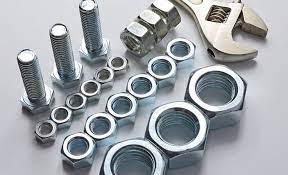Nuts and bolts are ubiquitous fasteners that play a vital role in countless applications across various industries. Whether you’re assembling furniture, constructing buildings, or working on automotive projects, selecting the right nuts and bolts is essential for ensuring secure and reliable connections. In this article, we will explore different types of nuts and bolts, their unique features, and the applications they are commonly used in. Let’s dive in!
- Hex Nuts and Bolts:
Hex nuts and bolts are among the most common types of fasteners used worldwide. They have six-sided heads and are available in a variety of sizes and materials, including steel, stainless steel, and brass. Hex nuts and bolts provide excellent torque transfer, making them ideal for applications where high clamping force is required, such as machinery, automotive, and construction.
- Wing Nuts and Bolts:
Wing nuts and bolts are designed for easy hand tightening and loosening without the need for tools. They feature wing-like projections on their heads, providing a convenient grip. 316 Stainless Wing Nuts and bolts are commonly used in applications that require frequent adjustments or quick assembly and disassembly, such as furniture, lighting fixtures, and equipment with manual operation.
- Lock Nuts and Bolts:
Lock nuts and bolts are specifically designed to prevent loosening due to vibrations or external forces. They employ various mechanisms like nylon inserts, prevailing torque features, or serrated flanges to create resistance against unintended rotation. Lock nuts and bolts are crucial in industries where safety and reliability are paramount, including automotive, aerospace, and machinery.
- Flange Nuts and Bolts:
Flange nuts and bolts have built-in washer-like flanges beneath their heads. The flange provides a larger load-bearing surface, which helps distribute the clamping force and reduces the risk of damage to the connected surface. These fasteners are commonly used in applications where vibration resistance and increased surface contact are necessary, such as automotive engine assemblies, pipelines, and structural frameworks.
- Rivet Nuts and Bolts:
Rivet nuts and bolts, also known as blind rivets or threaded inserts, are unique fasteners that are installed from one side of the workpiece. They are often used when access to the rear side is restricted. Rivet nuts and bolts create a threaded hole that allows for the attachment of other components. They are widely used in industries such as aerospace, electronics, and automotive for assembly and repair applications.
- Sleeve Nuts and Bolts:
Sleeve nuts and bolts consist of a cylindrical sleeve with internal threads. These fasteners are used to connect two components by threading the bolt through one component and screwing it into the sleeve nut on the other side. Sleeve nuts and bolts are commonly found in furniture assembly, railings, and architectural applications.
Conclusion:
Choosing the right nuts and bolts is crucial for achieving strong, secure, and reliable connections in various applications. Understanding the different types of fasteners available, their unique features, and the specific requirements of your project will help you make informed decisions. Whether you need high clamping force, vibration resistance, easy adjustability, or specialized installation methods, there is a type of nut and bolt designed to meet your needs. By selecting the appropriate fasteners, you can ensure the success and longevity of your projects.
James Martin is a passionate writer and the founder of OnTimeMagazines & EastLifePro. He loves to write principally about technology trends. He loves to share his opinion on what’s happening in tech around the world.


